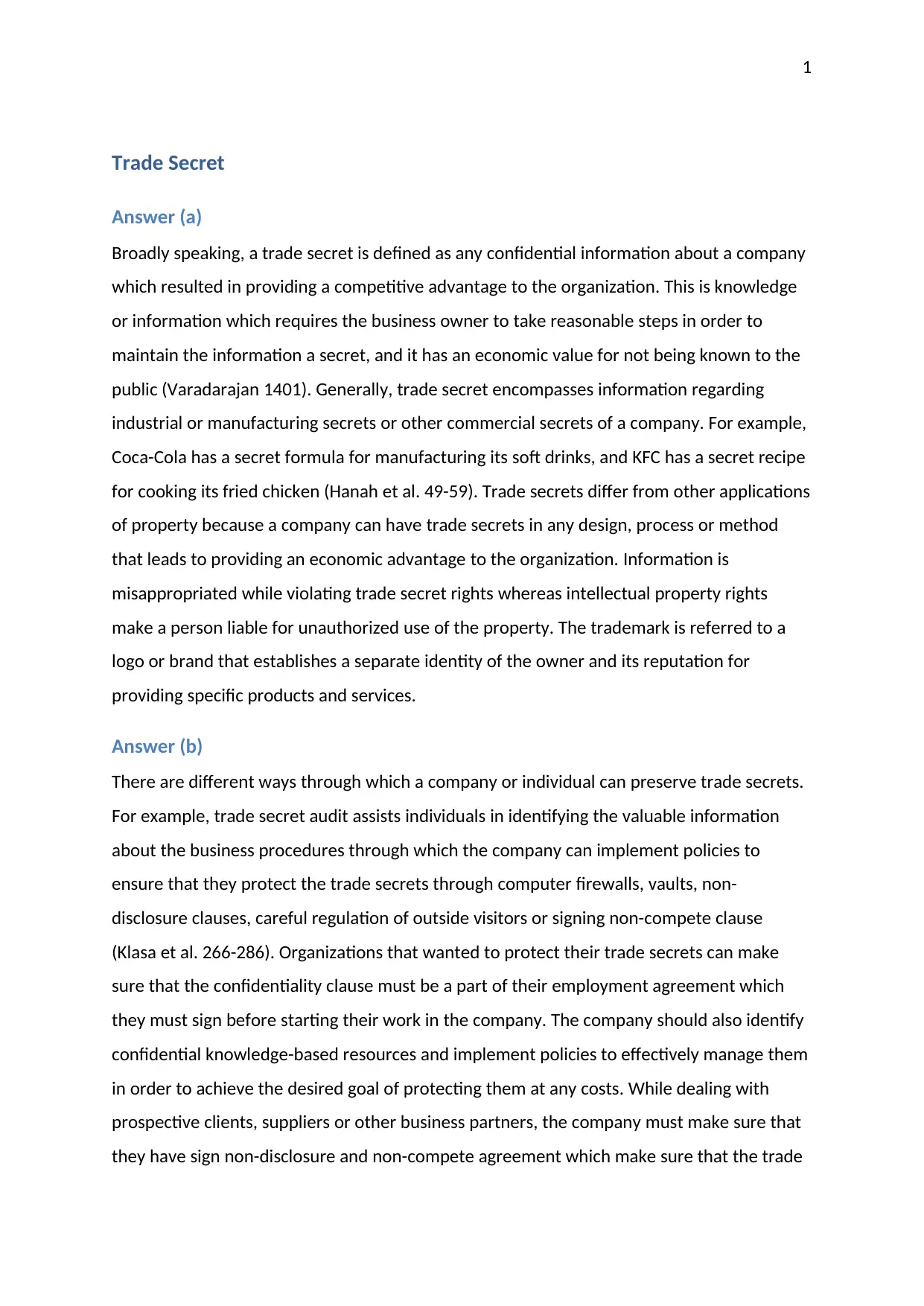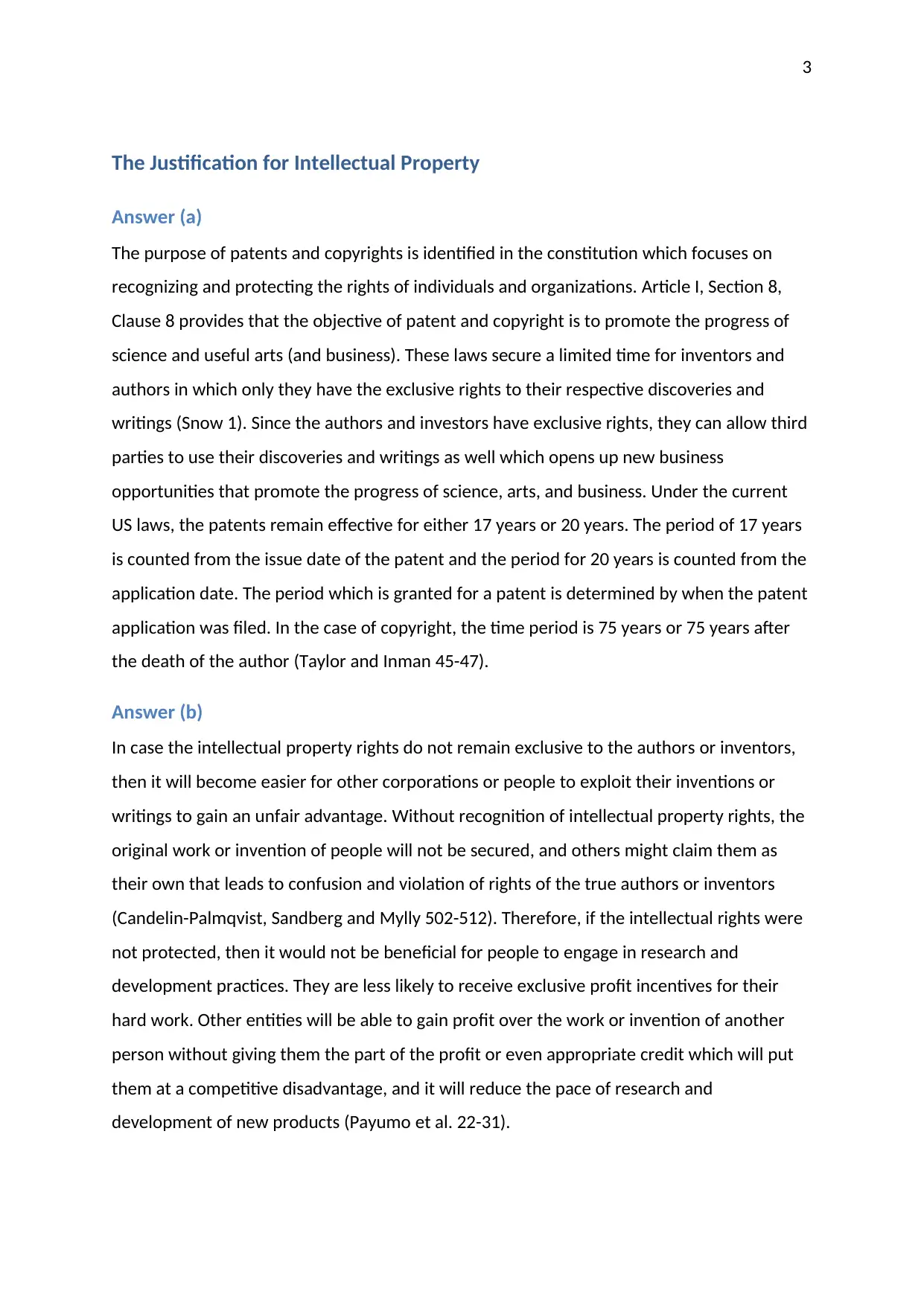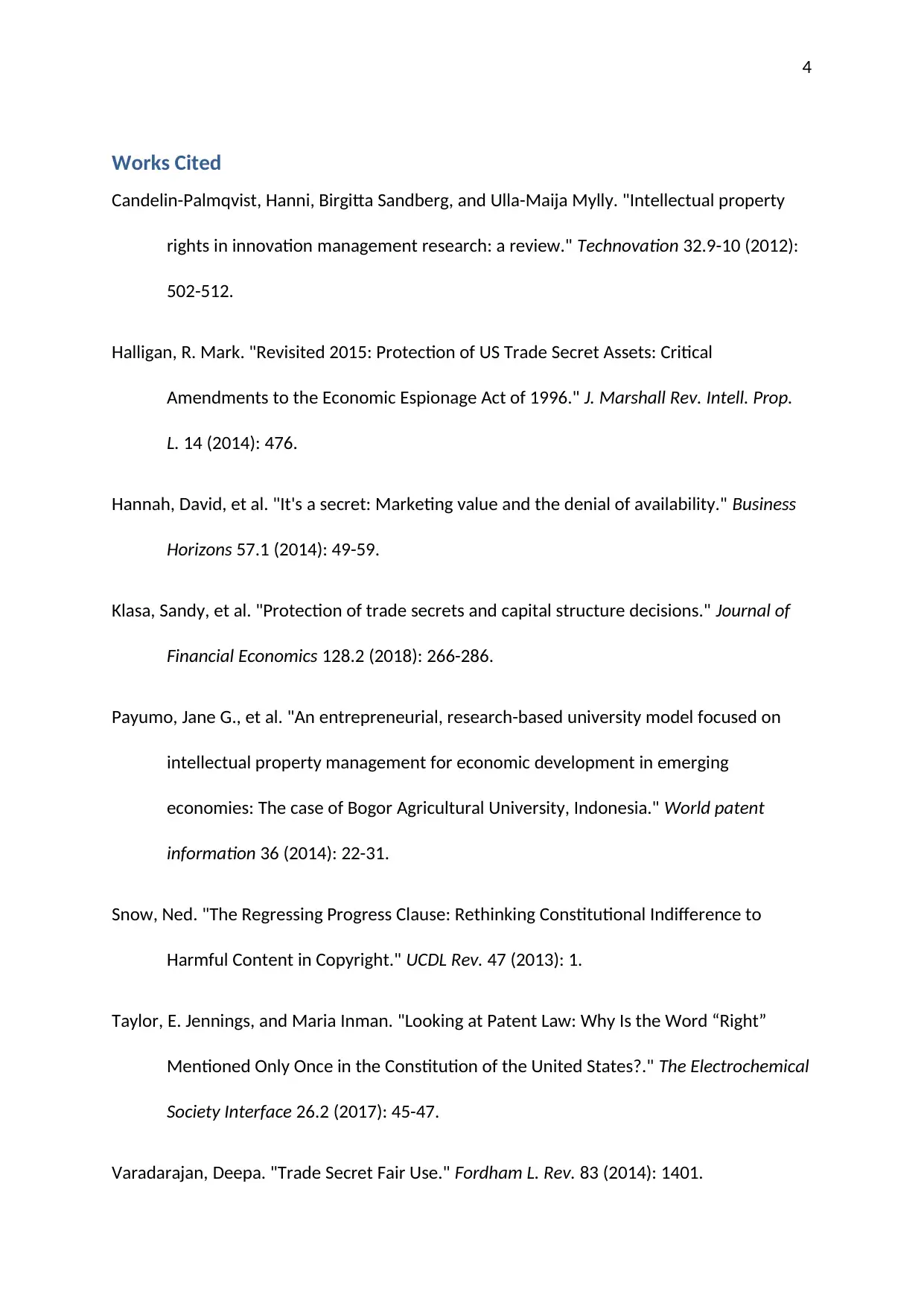Trade Secrets and Intellectual Property: A Business Law Perspective
VerifiedAdded on 2023/04/21
|5
|1121
|174
Essay
AI Summary
This essay delves into the realm of trade secrets and intellectual property within the framework of business law. It begins by defining trade secrets as confidential information providing a competitive edge, emphasizing the need for reasonable protection measures and economic value. The discussion differentiates trade secrets from other intellectual property rights like trademarks. Furthermore, it explores methods for preserving trade secrets, such as trade secret audits, confidentiality clauses, and secure data management. The essay then justifies intellectual property rights, particularly patents and copyrights, by highlighting their constitutional purpose in promoting science and the arts. It addresses the potential consequences of lacking exclusive intellectual property rights, including exploitation, reduced innovation incentives, and competitive disadvantages. The work references several academic sources to support its arguments and provide a comprehensive overview of the subject matter.

0
Business Law Assignment
Business Law Assignment
Paraphrase This Document
Need a fresh take? Get an instant paraphrase of this document with our AI Paraphraser

1
Trade Secret
Answer (a)
Broadly speaking, a trade secret is defined as any confidential information about a company
which resulted in providing a competitive advantage to the organization. This is knowledge
or information which requires the business owner to take reasonable steps in order to
maintain the information a secret, and it has an economic value for not being known to the
public (Varadarajan 1401). Generally, trade secret encompasses information regarding
industrial or manufacturing secrets or other commercial secrets of a company. For example,
Coca-Cola has a secret formula for manufacturing its soft drinks, and KFC has a secret recipe
for cooking its fried chicken (Hanah et al. 49-59). Trade secrets differ from other applications
of property because a company can have trade secrets in any design, process or method
that leads to providing an economic advantage to the organization. Information is
misappropriated while violating trade secret rights whereas intellectual property rights
make a person liable for unauthorized use of the property. The trademark is referred to a
logo or brand that establishes a separate identity of the owner and its reputation for
providing specific products and services.
Answer (b)
There are different ways through which a company or individual can preserve trade secrets.
For example, trade secret audit assists individuals in identifying the valuable information
about the business procedures through which the company can implement policies to
ensure that they protect the trade secrets through computer firewalls, vaults, non-
disclosure clauses, careful regulation of outside visitors or signing non-compete clause
(Klasa et al. 266-286). Organizations that wanted to protect their trade secrets can make
sure that the confidentiality clause must be a part of their employment agreement which
they must sign before starting their work in the company. The company should also identify
confidential knowledge-based resources and implement policies to effectively manage them
in order to achieve the desired goal of protecting them at any costs. While dealing with
prospective clients, suppliers or other business partners, the company must make sure that
they have sign non-disclosure and non-compete agreement which make sure that the trade
Trade Secret
Answer (a)
Broadly speaking, a trade secret is defined as any confidential information about a company
which resulted in providing a competitive advantage to the organization. This is knowledge
or information which requires the business owner to take reasonable steps in order to
maintain the information a secret, and it has an economic value for not being known to the
public (Varadarajan 1401). Generally, trade secret encompasses information regarding
industrial or manufacturing secrets or other commercial secrets of a company. For example,
Coca-Cola has a secret formula for manufacturing its soft drinks, and KFC has a secret recipe
for cooking its fried chicken (Hanah et al. 49-59). Trade secrets differ from other applications
of property because a company can have trade secrets in any design, process or method
that leads to providing an economic advantage to the organization. Information is
misappropriated while violating trade secret rights whereas intellectual property rights
make a person liable for unauthorized use of the property. The trademark is referred to a
logo or brand that establishes a separate identity of the owner and its reputation for
providing specific products and services.
Answer (b)
There are different ways through which a company or individual can preserve trade secrets.
For example, trade secret audit assists individuals in identifying the valuable information
about the business procedures through which the company can implement policies to
ensure that they protect the trade secrets through computer firewalls, vaults, non-
disclosure clauses, careful regulation of outside visitors or signing non-compete clause
(Klasa et al. 266-286). Organizations that wanted to protect their trade secrets can make
sure that the confidentiality clause must be a part of their employment agreement which
they must sign before starting their work in the company. The company should also identify
confidential knowledge-based resources and implement policies to effectively manage them
in order to achieve the desired goal of protecting them at any costs. While dealing with
prospective clients, suppliers or other business partners, the company must make sure that
they have sign non-disclosure and non-compete agreement which make sure that the trade

2
secrets of the company are safe (Halligan 476). In the digital era, securing computer-stored
information through encryption and firewall is important to make sure that trade secrets
remain safe from unauthorized access.
secrets of the company are safe (Halligan 476). In the digital era, securing computer-stored
information through encryption and firewall is important to make sure that trade secrets
remain safe from unauthorized access.
⊘ This is a preview!⊘
Do you want full access?
Subscribe today to unlock all pages.

Trusted by 1+ million students worldwide

3
The Justification for Intellectual Property
Answer (a)
The purpose of patents and copyrights is identified in the constitution which focuses on
recognizing and protecting the rights of individuals and organizations. Article I, Section 8,
Clause 8 provides that the objective of patent and copyright is to promote the progress of
science and useful arts (and business). These laws secure a limited time for inventors and
authors in which only they have the exclusive rights to their respective discoveries and
writings (Snow 1). Since the authors and investors have exclusive rights, they can allow third
parties to use their discoveries and writings as well which opens up new business
opportunities that promote the progress of science, arts, and business. Under the current
US laws, the patents remain effective for either 17 years or 20 years. The period of 17 years
is counted from the issue date of the patent and the period for 20 years is counted from the
application date. The period which is granted for a patent is determined by when the patent
application was filed. In the case of copyright, the time period is 75 years or 75 years after
the death of the author (Taylor and Inman 45-47).
Answer (b)
In case the intellectual property rights do not remain exclusive to the authors or inventors,
then it will become easier for other corporations or people to exploit their inventions or
writings to gain an unfair advantage. Without recognition of intellectual property rights, the
original work or invention of people will not be secured, and others might claim them as
their own that leads to confusion and violation of rights of the true authors or inventors
(Candelin-Palmqvist, Sandberg and Mylly 502-512). Therefore, if the intellectual rights were
not protected, then it would not be beneficial for people to engage in research and
development practices. They are less likely to receive exclusive profit incentives for their
hard work. Other entities will be able to gain profit over the work or invention of another
person without giving them the part of the profit or even appropriate credit which will put
them at a competitive disadvantage, and it will reduce the pace of research and
development of new products (Payumo et al. 22-31).
The Justification for Intellectual Property
Answer (a)
The purpose of patents and copyrights is identified in the constitution which focuses on
recognizing and protecting the rights of individuals and organizations. Article I, Section 8,
Clause 8 provides that the objective of patent and copyright is to promote the progress of
science and useful arts (and business). These laws secure a limited time for inventors and
authors in which only they have the exclusive rights to their respective discoveries and
writings (Snow 1). Since the authors and investors have exclusive rights, they can allow third
parties to use their discoveries and writings as well which opens up new business
opportunities that promote the progress of science, arts, and business. Under the current
US laws, the patents remain effective for either 17 years or 20 years. The period of 17 years
is counted from the issue date of the patent and the period for 20 years is counted from the
application date. The period which is granted for a patent is determined by when the patent
application was filed. In the case of copyright, the time period is 75 years or 75 years after
the death of the author (Taylor and Inman 45-47).
Answer (b)
In case the intellectual property rights do not remain exclusive to the authors or inventors,
then it will become easier for other corporations or people to exploit their inventions or
writings to gain an unfair advantage. Without recognition of intellectual property rights, the
original work or invention of people will not be secured, and others might claim them as
their own that leads to confusion and violation of rights of the true authors or inventors
(Candelin-Palmqvist, Sandberg and Mylly 502-512). Therefore, if the intellectual rights were
not protected, then it would not be beneficial for people to engage in research and
development practices. They are less likely to receive exclusive profit incentives for their
hard work. Other entities will be able to gain profit over the work or invention of another
person without giving them the part of the profit or even appropriate credit which will put
them at a competitive disadvantage, and it will reduce the pace of research and
development of new products (Payumo et al. 22-31).
Paraphrase This Document
Need a fresh take? Get an instant paraphrase of this document with our AI Paraphraser

4
Works Cited
Candelin-Palmqvist, Hanni, Birgitta Sandberg, and Ulla-Maija Mylly. "Intellectual property
rights in innovation management research: a review." Technovation 32.9-10 (2012):
502-512.
Halligan, R. Mark. "Revisited 2015: Protection of US Trade Secret Assets: Critical
Amendments to the Economic Espionage Act of 1996." J. Marshall Rev. Intell. Prop.
L. 14 (2014): 476.
Hannah, David, et al. "It's a secret: Marketing value and the denial of availability." Business
Horizons 57.1 (2014): 49-59.
Klasa, Sandy, et al. "Protection of trade secrets and capital structure decisions." Journal of
Financial Economics 128.2 (2018): 266-286.
Payumo, Jane G., et al. "An entrepreneurial, research-based university model focused on
intellectual property management for economic development in emerging
economies: The case of Bogor Agricultural University, Indonesia." World patent
information 36 (2014): 22-31.
Snow, Ned. "The Regressing Progress Clause: Rethinking Constitutional Indifference to
Harmful Content in Copyright." UCDL Rev. 47 (2013): 1.
Taylor, E. Jennings, and Maria Inman. "Looking at Patent Law: Why Is the Word “Right”
Mentioned Only Once in the Constitution of the United States?." The Electrochemical
Society Interface 26.2 (2017): 45-47.
Varadarajan, Deepa. "Trade Secret Fair Use." Fordham L. Rev. 83 (2014): 1401.
Works Cited
Candelin-Palmqvist, Hanni, Birgitta Sandberg, and Ulla-Maija Mylly. "Intellectual property
rights in innovation management research: a review." Technovation 32.9-10 (2012):
502-512.
Halligan, R. Mark. "Revisited 2015: Protection of US Trade Secret Assets: Critical
Amendments to the Economic Espionage Act of 1996." J. Marshall Rev. Intell. Prop.
L. 14 (2014): 476.
Hannah, David, et al. "It's a secret: Marketing value and the denial of availability." Business
Horizons 57.1 (2014): 49-59.
Klasa, Sandy, et al. "Protection of trade secrets and capital structure decisions." Journal of
Financial Economics 128.2 (2018): 266-286.
Payumo, Jane G., et al. "An entrepreneurial, research-based university model focused on
intellectual property management for economic development in emerging
economies: The case of Bogor Agricultural University, Indonesia." World patent
information 36 (2014): 22-31.
Snow, Ned. "The Regressing Progress Clause: Rethinking Constitutional Indifference to
Harmful Content in Copyright." UCDL Rev. 47 (2013): 1.
Taylor, E. Jennings, and Maria Inman. "Looking at Patent Law: Why Is the Word “Right”
Mentioned Only Once in the Constitution of the United States?." The Electrochemical
Society Interface 26.2 (2017): 45-47.
Varadarajan, Deepa. "Trade Secret Fair Use." Fordham L. Rev. 83 (2014): 1401.
1 out of 5
Related Documents
Your All-in-One AI-Powered Toolkit for Academic Success.
+13062052269
info@desklib.com
Available 24*7 on WhatsApp / Email
![[object Object]](/_next/static/media/star-bottom.7253800d.svg)
Unlock your academic potential
Copyright © 2020–2025 A2Z Services. All Rights Reserved. Developed and managed by ZUCOL.





